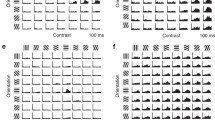Summary
Single lines cause changes in the apparent orientation of nearby lines of somewhat different orientation: acute angles are perceptually expanded while obtuse angles apparently contract. This phenomenon is measured by a matching technique and evidence is presented that it is due to recurrent, inhibitory interactions among orientation selective neural channels. In particular, a third line added to an angle figure can have a disinhibiting effect on the orientational distortion. Orientation selective channels maximally sensitive to different orientations may have different distributions of inhibitory input in the orientation domain. The results are interpreted in terms of the organization of neurones in the visual cortex. Each cell may receive a crude orientation selectivity from its direct input, and be inhibited, over an even broader range of orientation, by neurones in the same column and adjacent ones.
Similar content being viewed by others
References
Andrews, D.P.: Perception of contours in the central fovea. Nature (Lond.) 205, 1218–1220 (1965).
—: Perception of contour orientation in the central fovea. Vision Res. 7, 975–1013 (1967).
von Békésy, G.: Sensory Inhibition. Princeton: University Press 1967.
Benevento, L.A., Creutzfeldt, O.D., Kuhnt, U: Significance of intracortical inhibition in the visual cortex. Nature New Biology 238, 124–126 (1972).
Blakemore, C., Campbell, F.W.: On the existence of neurones in the human visual system selectively sensitive to the orientation and size of retinal images. J. Physiol. (Lond.) 203, 237–260 (1969).
—, Carpenter, R.H.S., Georgeson, M.A.: Lateral inhibition between orientation detectors in the human visual system. Nature (Lond.) 228, 37–39 (1970).
—: Lateral inhibition between orientation detectors in the cat's visual cortex. Exp. Brain Res. 15, 439–440 (1972).
Bouma, H., Andriessen, J.J.: Perceived orientation of isolated line segments. Vision Res. 8, 493–507 (1968).
—: Induced changes in the perceived orientation of line segments. Vision Res. 10, 333–349 (1970).
Chiang, C.: A new theory to explain geometrical illusions produced by erossing lines. Perception and Psychophysics 4, 174–176 (1968).
Coltheart, M.: Visual feature-analyzers and after-effects of tilt and curvature. Psychol. Rev. 78, 114–121 (1971).
Coren, S.: Lateral inhibition and geometric illusions. Quart. J. exp. Psychol. 22, 274–278 (1970).
Cronly-Dillon, J.R.: Units sensitive to direction of movement in goldfish optic tectum. Nature (Lond.) 203, 214–215 (1964).
Cumming, G.D.: A criticism of the diffraction theory of some geometric illusions. Perception and Psychophysics 4, 375–376 (1968).
Fisher, G.H.: An experimental study of angular subtension. Quart. J. exp. Psychol. 21, 356–366 (1969).
Ganz, L.: Mechanism of the figural after-effect. Psychol. Rev. 73, 128–150 (1966).
Gibson, J.J.: Adaptation, after-effect and contrast in the perception of tilted lines: II. Simultaneous contrast and the areal restriction of the after-effect. J. exp. Psychol. 20, 553–569 (1937).
Gregory, R.L.: Eye and Brain: the Psychology of Seeing. World University Library. London: Weidenfield and Nicolson 1966.
Hotopf, W.H.N., Ollerearnshaw, C.: The regression to right angles tendency and the Poggendorff illusion. Brit. J. Psychol. 63, 359–367 (1972).
Hubel, D.H., Wiesel, T.N.: Receptive fields, binocular interaction and functional architecture in the cat's visual cortex. J. Physiol. (Lond.) 160, 106–154 (1962).
—: Shape and arrangement of columns in cat's striate cortex. J. Physiol. (Lond.) 165, 559–568 (1963).
—: Receptive fields and functional architecture of monkey striate cortex. J. Physiol. (Lond.) 195, 215–243 (1968).
Köhler, W., Wallach, H.: Figural after-effects: an investigation of visual processes. Proc. Amer. Philos. Soc. 88, 269–357 (1944).
Levick, W.R.: Receptive fields and trigger features of ganglion cells in the visual streak of the rabbit's retina. J. Physiol. (Lond.) 188, 285–307 (1967).
Luckiesh, M.: Visual illusions: Their Causes, Characteristics and Applications. New York: Van Nostrand 1922.
Marg, E., Adams, J.E., Rutkin, B.: Receptive fields of cells in the human visual cortex. Experientia (Basel) 24, 348–350 (1968).
Maturana, H.R., Frenk, S.: Directional movement and horizontal edge detectors in the pigeon retina. Science 142, 977–979 (1963).
Michael, C.R.: Visual receptive fields of single neurones in the superior colliculus of the ground squirrel. J. Neurophysiol, 35, 815–832 (1972).
Nelson, J.: Illusions as the Mach bands of contour detectors. Paper presented at a conference on Contour interaction in the visual system: Cambridge: 1971.
Sutherland, N.S.: Figural after-effects and apparent size. Quart. J. exp. Psychol. 13, 222–228 (1961).
Wallace, G.K.: The critical distance of interaction in the Zöllner illusion. Perception and Psychophysics 5, 261–264 (1969).
Weintraub, D.J., Virsu, V.: Estimating the vertex of converging lines: Angle misperception? Perception and Psychophysics 11, 277–283 (1972).
Author information
Authors and Affiliations
Rights and permissions
About this article
Cite this article
Carpenter, R.H.S., Blakemore, C. Interactions between orientations in human vision. Exp Brain Res 18, 287–303 (1973). https://doi.org/10.1007/BF00234599
Received:
Issue Date:
DOI: https://doi.org/10.1007/BF00234599




